Strategic Management of Vodafone Plc
VerifiedAdded on 2023/01/19
|17
|5245
|22
AI Summary
This assignment provides an analysis of the strategic management of Vodafone Plc, including its recent failures, internal and external analysis, and strategic recommendations. It focuses on the company's mission, vision, objectives, and strategic capabilities.
Contribute Materials
Your contribution can guide someone’s learning journey. Share your
documents today.
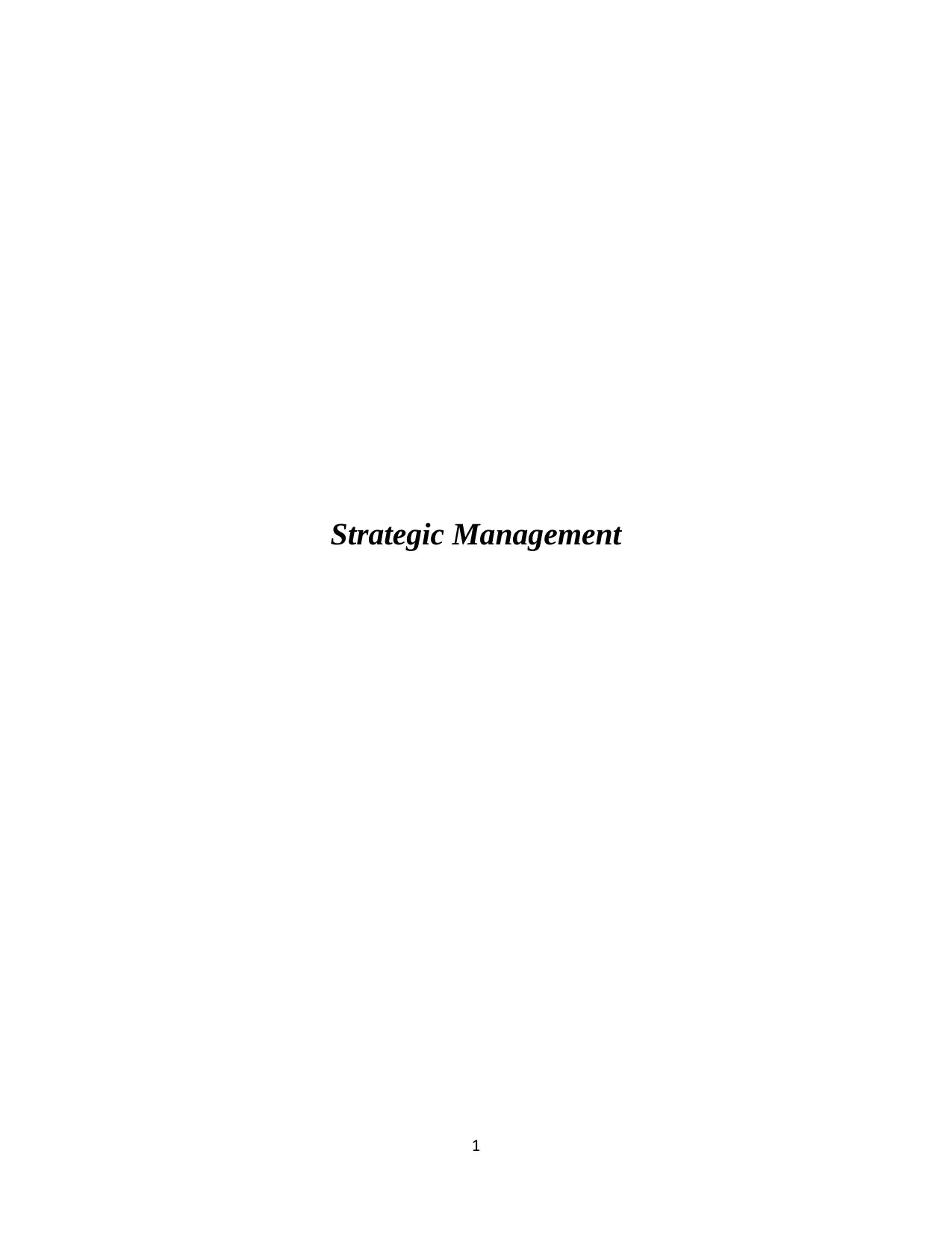
Strategic Management
1
1
Secure Best Marks with AI Grader
Need help grading? Try our AI Grader for instant feedback on your assignments.
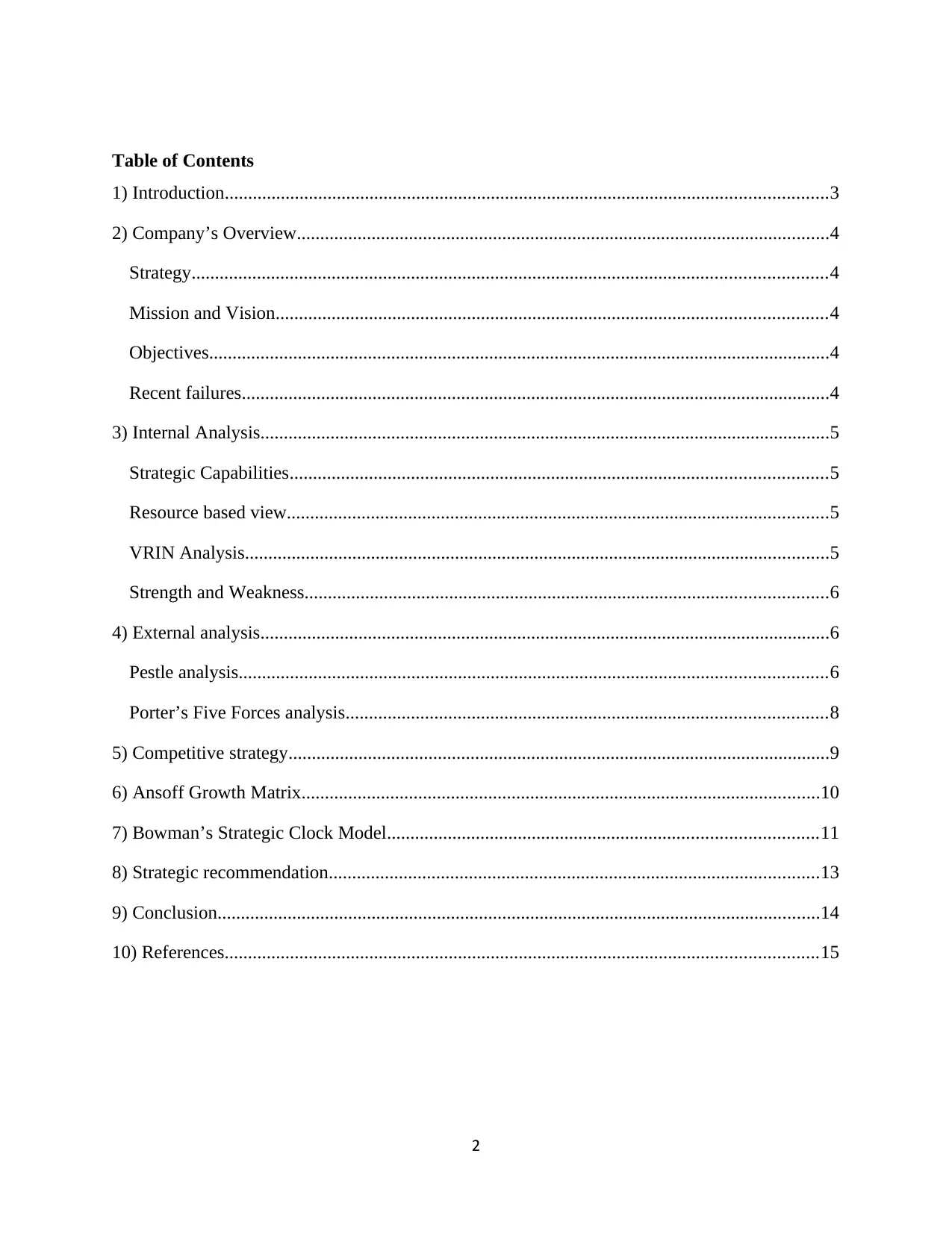
Table of Contents
1) Introduction.................................................................................................................................3
2) Company’s Overview..................................................................................................................4
Strategy........................................................................................................................................4
Mission and Vision......................................................................................................................4
Objectives.....................................................................................................................................4
Recent failures..............................................................................................................................4
3) Internal Analysis..........................................................................................................................5
Strategic Capabilities...................................................................................................................5
Resource based view....................................................................................................................5
VRIN Analysis.............................................................................................................................5
Strength and Weakness................................................................................................................6
4) External analysis..........................................................................................................................6
Pestle analysis..............................................................................................................................6
Porter’s Five Forces analysis.......................................................................................................8
5) Competitive strategy....................................................................................................................9
6) Ansoff Growth Matrix...............................................................................................................10
7) Bowman’s Strategic Clock Model............................................................................................11
8) Strategic recommendation.........................................................................................................13
9) Conclusion.................................................................................................................................14
10) References...............................................................................................................................15
2
1) Introduction.................................................................................................................................3
2) Company’s Overview..................................................................................................................4
Strategy........................................................................................................................................4
Mission and Vision......................................................................................................................4
Objectives.....................................................................................................................................4
Recent failures..............................................................................................................................4
3) Internal Analysis..........................................................................................................................5
Strategic Capabilities...................................................................................................................5
Resource based view....................................................................................................................5
VRIN Analysis.............................................................................................................................5
Strength and Weakness................................................................................................................6
4) External analysis..........................................................................................................................6
Pestle analysis..............................................................................................................................6
Porter’s Five Forces analysis.......................................................................................................8
5) Competitive strategy....................................................................................................................9
6) Ansoff Growth Matrix...............................................................................................................10
7) Bowman’s Strategic Clock Model............................................................................................11
8) Strategic recommendation.........................................................................................................13
9) Conclusion.................................................................................................................................14
10) References...............................................................................................................................15
2
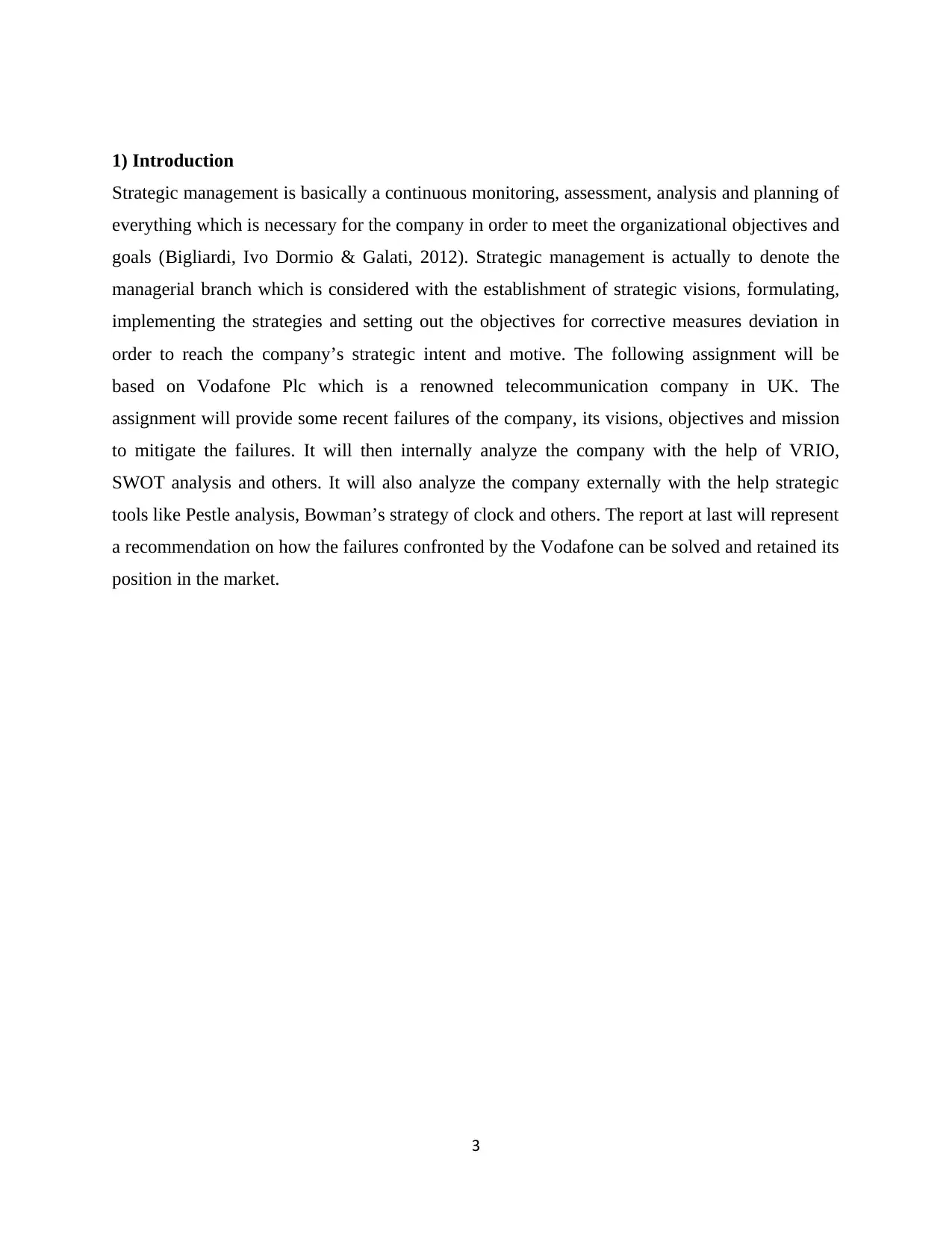
1) Introduction
Strategic management is basically a continuous monitoring, assessment, analysis and planning of
everything which is necessary for the company in order to meet the organizational objectives and
goals (Bigliardi, Ivo Dormio & Galati, 2012). Strategic management is actually to denote the
managerial branch which is considered with the establishment of strategic visions, formulating,
implementing the strategies and setting out the objectives for corrective measures deviation in
order to reach the company’s strategic intent and motive. The following assignment will be
based on Vodafone Plc which is a renowned telecommunication company in UK. The
assignment will provide some recent failures of the company, its visions, objectives and mission
to mitigate the failures. It will then internally analyze the company with the help of VRIO,
SWOT analysis and others. It will also analyze the company externally with the help strategic
tools like Pestle analysis, Bowman’s strategy of clock and others. The report at last will represent
a recommendation on how the failures confronted by the Vodafone can be solved and retained its
position in the market.
3
Strategic management is basically a continuous monitoring, assessment, analysis and planning of
everything which is necessary for the company in order to meet the organizational objectives and
goals (Bigliardi, Ivo Dormio & Galati, 2012). Strategic management is actually to denote the
managerial branch which is considered with the establishment of strategic visions, formulating,
implementing the strategies and setting out the objectives for corrective measures deviation in
order to reach the company’s strategic intent and motive. The following assignment will be
based on Vodafone Plc which is a renowned telecommunication company in UK. The
assignment will provide some recent failures of the company, its visions, objectives and mission
to mitigate the failures. It will then internally analyze the company with the help of VRIO,
SWOT analysis and others. It will also analyze the company externally with the help strategic
tools like Pestle analysis, Bowman’s strategy of clock and others. The report at last will represent
a recommendation on how the failures confronted by the Vodafone can be solved and retained its
position in the market.
3
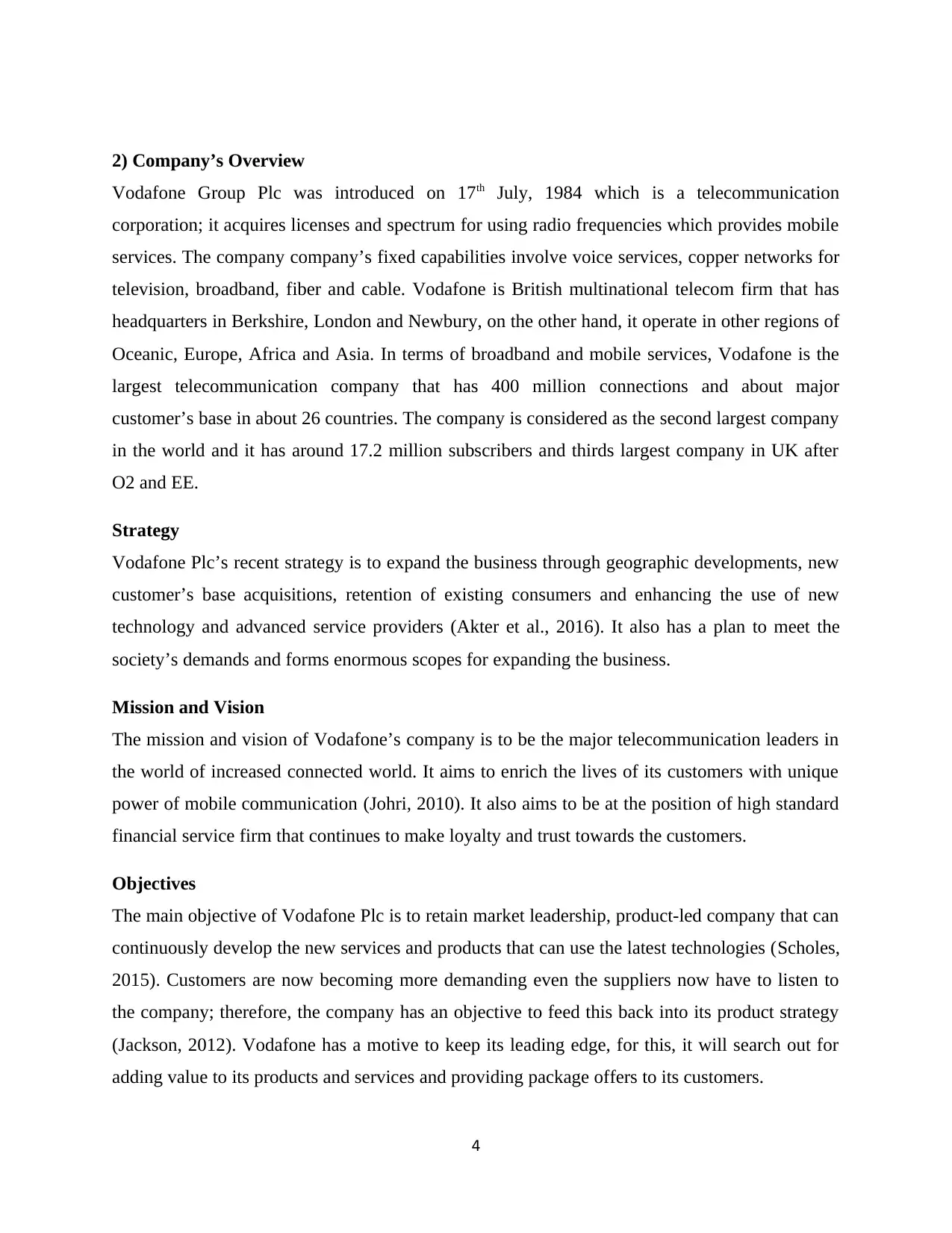
2) Company’s Overview
Vodafone Group Plc was introduced on 17th July, 1984 which is a telecommunication
corporation; it acquires licenses and spectrum for using radio frequencies which provides mobile
services. The company company’s fixed capabilities involve voice services, copper networks for
television, broadband, fiber and cable. Vodafone is British multinational telecom firm that has
headquarters in Berkshire, London and Newbury, on the other hand, it operate in other regions of
Oceanic, Europe, Africa and Asia. In terms of broadband and mobile services, Vodafone is the
largest telecommunication company that has 400 million connections and about major
customer’s base in about 26 countries. The company is considered as the second largest company
in the world and it has around 17.2 million subscribers and thirds largest company in UK after
O2 and EE.
Strategy
Vodafone Plc’s recent strategy is to expand the business through geographic developments, new
customer’s base acquisitions, retention of existing consumers and enhancing the use of new
technology and advanced service providers (Akter et al., 2016). It also has a plan to meet the
society’s demands and forms enormous scopes for expanding the business.
Mission and Vision
The mission and vision of Vodafone’s company is to be the major telecommunication leaders in
the world of increased connected world. It aims to enrich the lives of its customers with unique
power of mobile communication (Johri, 2010). It also aims to be at the position of high standard
financial service firm that continues to make loyalty and trust towards the customers.
Objectives
The main objective of Vodafone Plc is to retain market leadership, product-led company that can
continuously develop the new services and products that can use the latest technologies (Scholes,
2015). Customers are now becoming more demanding even the suppliers now have to listen to
the company; therefore, the company has an objective to feed this back into its product strategy
(Jackson, 2012). Vodafone has a motive to keep its leading edge, for this, it will search out for
adding value to its products and services and providing package offers to its customers.
4
Vodafone Group Plc was introduced on 17th July, 1984 which is a telecommunication
corporation; it acquires licenses and spectrum for using radio frequencies which provides mobile
services. The company company’s fixed capabilities involve voice services, copper networks for
television, broadband, fiber and cable. Vodafone is British multinational telecom firm that has
headquarters in Berkshire, London and Newbury, on the other hand, it operate in other regions of
Oceanic, Europe, Africa and Asia. In terms of broadband and mobile services, Vodafone is the
largest telecommunication company that has 400 million connections and about major
customer’s base in about 26 countries. The company is considered as the second largest company
in the world and it has around 17.2 million subscribers and thirds largest company in UK after
O2 and EE.
Strategy
Vodafone Plc’s recent strategy is to expand the business through geographic developments, new
customer’s base acquisitions, retention of existing consumers and enhancing the use of new
technology and advanced service providers (Akter et al., 2016). It also has a plan to meet the
society’s demands and forms enormous scopes for expanding the business.
Mission and Vision
The mission and vision of Vodafone’s company is to be the major telecommunication leaders in
the world of increased connected world. It aims to enrich the lives of its customers with unique
power of mobile communication (Johri, 2010). It also aims to be at the position of high standard
financial service firm that continues to make loyalty and trust towards the customers.
Objectives
The main objective of Vodafone Plc is to retain market leadership, product-led company that can
continuously develop the new services and products that can use the latest technologies (Scholes,
2015). Customers are now becoming more demanding even the suppliers now have to listen to
the company; therefore, the company has an objective to feed this back into its product strategy
(Jackson, 2012). Vodafone has a motive to keep its leading edge, for this, it will search out for
adding value to its products and services and providing package offers to its customers.
4
Secure Best Marks with AI Grader
Need help grading? Try our AI Grader for instant feedback on your assignments.

Recent failures
Being the world’s second largest mobile operator company it failed to act quickly in identifying
or address the problems within the company. Recently, UK has fined the company for about
$5.60 million for customer’s failures that is a serious sustained as the company has failed to
update the accounts when the users or the customers topped up their credit for making calls
(Kourdi, 2015). The failings are serious and even unacceptable and the fines are the highest ever
imposed by the Britain and sent the company a clear warning to it and even other mobile
operators in UK. Vodafone has failed to provide customers satisfaction and this has become the
unhappy episodes for the entire major customer’s base of the company.
3) Internal Analysis
Strategic Capabilities
Strategic capabilities refers to the strength of the company such as it capacities, skills, people and
resources which provides it the competitive benefits. Strategic capabilities considered as the
ability of the company for harnessing its entire capabilities, resources and skills for attaining
competitive advantages, thus enhance its value instead of time (Sapolsky et al., 2015). Strategic
capabilities focus upon assets, market position and resources of the company that projects that
how successful it will be able to employ the strategies further. Strategic capability of Vodafone is
the major component in order to remain viable financially and even expanding the competitor’s
presence in a free market. They also involve investors who want to put the money of the
company into businesses with affordable scopes of future growth and success (Scholes, 2015).
For Vodafone, strategic capabilities play the major role in the successful investments in its new
billing system for customer’s losses. The strategy of new billing system can be created by
Vodafone since it does have the capability for strategy implementation. The actual reason why
Vodafone is the second largest telecom company in the world is due to its string present in
Internet of Things. It has 400 million connections and about major customer’s base in about 26
countries. The firm also planned to provide end- to- end solution to the customers who faced
losses due to serious sustained and solutions are like cloud enabled, remote monitoring, usage-
based insurance and others.
5
Being the world’s second largest mobile operator company it failed to act quickly in identifying
or address the problems within the company. Recently, UK has fined the company for about
$5.60 million for customer’s failures that is a serious sustained as the company has failed to
update the accounts when the users or the customers topped up their credit for making calls
(Kourdi, 2015). The failings are serious and even unacceptable and the fines are the highest ever
imposed by the Britain and sent the company a clear warning to it and even other mobile
operators in UK. Vodafone has failed to provide customers satisfaction and this has become the
unhappy episodes for the entire major customer’s base of the company.
3) Internal Analysis
Strategic Capabilities
Strategic capabilities refers to the strength of the company such as it capacities, skills, people and
resources which provides it the competitive benefits. Strategic capabilities considered as the
ability of the company for harnessing its entire capabilities, resources and skills for attaining
competitive advantages, thus enhance its value instead of time (Sapolsky et al., 2015). Strategic
capabilities focus upon assets, market position and resources of the company that projects that
how successful it will be able to employ the strategies further. Strategic capability of Vodafone is
the major component in order to remain viable financially and even expanding the competitor’s
presence in a free market. They also involve investors who want to put the money of the
company into businesses with affordable scopes of future growth and success (Scholes, 2015).
For Vodafone, strategic capabilities play the major role in the successful investments in its new
billing system for customer’s losses. The strategy of new billing system can be created by
Vodafone since it does have the capability for strategy implementation. The actual reason why
Vodafone is the second largest telecom company in the world is due to its string present in
Internet of Things. It has 400 million connections and about major customer’s base in about 26
countries. The firm also planned to provide end- to- end solution to the customers who faced
losses due to serious sustained and solutions are like cloud enabled, remote monitoring, usage-
based insurance and others.
5
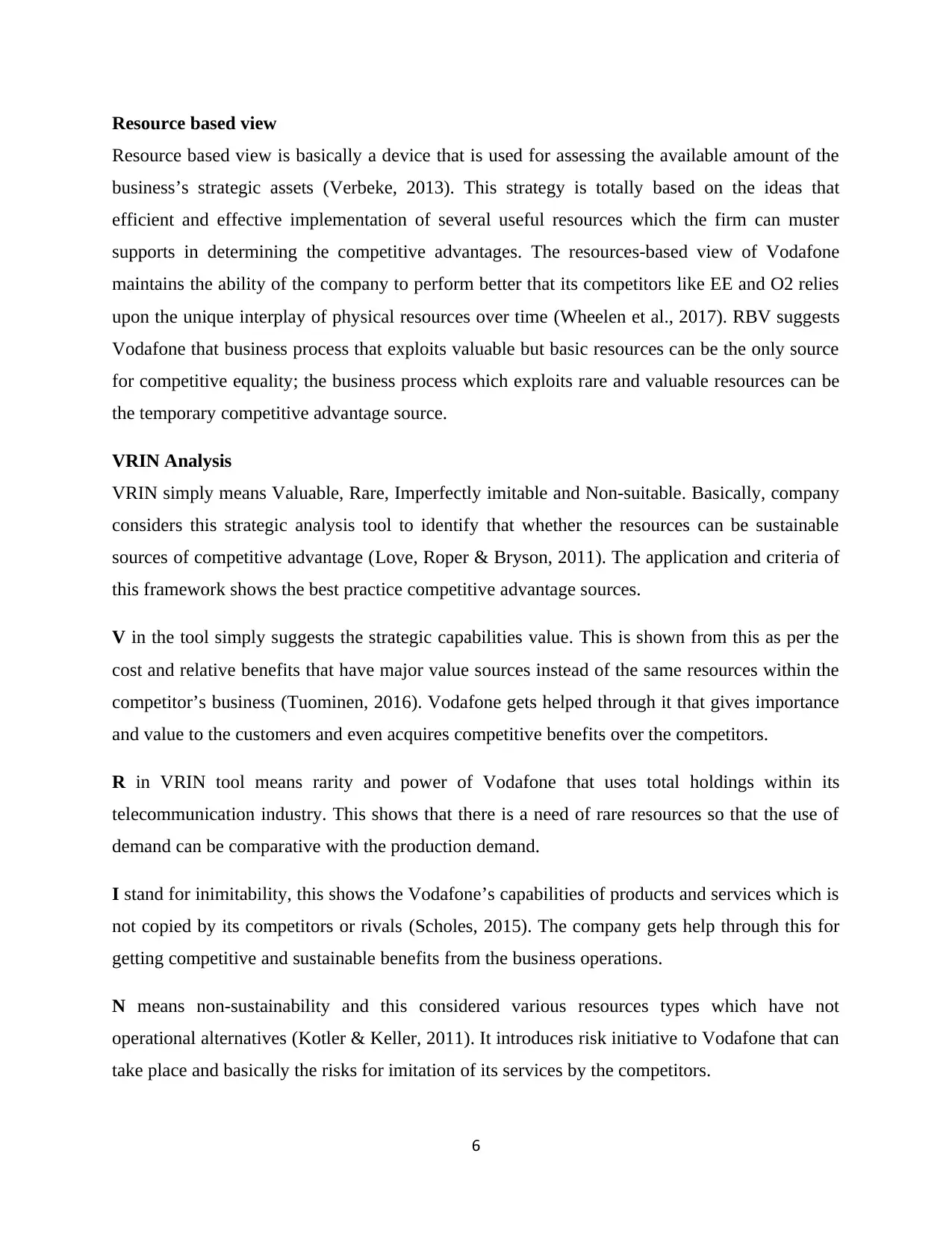
Resource based view
Resource based view is basically a device that is used for assessing the available amount of the
business’s strategic assets (Verbeke, 2013). This strategy is totally based on the ideas that
efficient and effective implementation of several useful resources which the firm can muster
supports in determining the competitive advantages. The resources-based view of Vodafone
maintains the ability of the company to perform better that its competitors like EE and O2 relies
upon the unique interplay of physical resources over time (Wheelen et al., 2017). RBV suggests
Vodafone that business process that exploits valuable but basic resources can be the only source
for competitive equality; the business process which exploits rare and valuable resources can be
the temporary competitive advantage source.
VRIN Analysis
VRIN simply means Valuable, Rare, Imperfectly imitable and Non-suitable. Basically, company
considers this strategic analysis tool to identify that whether the resources can be sustainable
sources of competitive advantage (Love, Roper & Bryson, 2011). The application and criteria of
this framework shows the best practice competitive advantage sources.
V in the tool simply suggests the strategic capabilities value. This is shown from this as per the
cost and relative benefits that have major value sources instead of the same resources within the
competitor’s business (Tuominen, 2016). Vodafone gets helped through it that gives importance
and value to the customers and even acquires competitive benefits over the competitors.
R in VRIN tool means rarity and power of Vodafone that uses total holdings within its
telecommunication industry. This shows that there is a need of rare resources so that the use of
demand can be comparative with the production demand.
I stand for inimitability, this shows the Vodafone’s capabilities of products and services which is
not copied by its competitors or rivals (Scholes, 2015). The company gets help through this for
getting competitive and sustainable benefits from the business operations.
N means non-sustainability and this considered various resources types which have not
operational alternatives (Kotler & Keller, 2011). It introduces risk initiative to Vodafone that can
take place and basically the risks for imitation of its services by the competitors.
6
Resource based view is basically a device that is used for assessing the available amount of the
business’s strategic assets (Verbeke, 2013). This strategy is totally based on the ideas that
efficient and effective implementation of several useful resources which the firm can muster
supports in determining the competitive advantages. The resources-based view of Vodafone
maintains the ability of the company to perform better that its competitors like EE and O2 relies
upon the unique interplay of physical resources over time (Wheelen et al., 2017). RBV suggests
Vodafone that business process that exploits valuable but basic resources can be the only source
for competitive equality; the business process which exploits rare and valuable resources can be
the temporary competitive advantage source.
VRIN Analysis
VRIN simply means Valuable, Rare, Imperfectly imitable and Non-suitable. Basically, company
considers this strategic analysis tool to identify that whether the resources can be sustainable
sources of competitive advantage (Love, Roper & Bryson, 2011). The application and criteria of
this framework shows the best practice competitive advantage sources.
V in the tool simply suggests the strategic capabilities value. This is shown from this as per the
cost and relative benefits that have major value sources instead of the same resources within the
competitor’s business (Tuominen, 2016). Vodafone gets helped through it that gives importance
and value to the customers and even acquires competitive benefits over the competitors.
R in VRIN tool means rarity and power of Vodafone that uses total holdings within its
telecommunication industry. This shows that there is a need of rare resources so that the use of
demand can be comparative with the production demand.
I stand for inimitability, this shows the Vodafone’s capabilities of products and services which is
not copied by its competitors or rivals (Scholes, 2015). The company gets help through this for
getting competitive and sustainable benefits from the business operations.
N means non-sustainability and this considered various resources types which have not
operational alternatives (Kotler & Keller, 2011). It introduces risk initiative to Vodafone that can
take place and basically the risks for imitation of its services by the competitors.
6
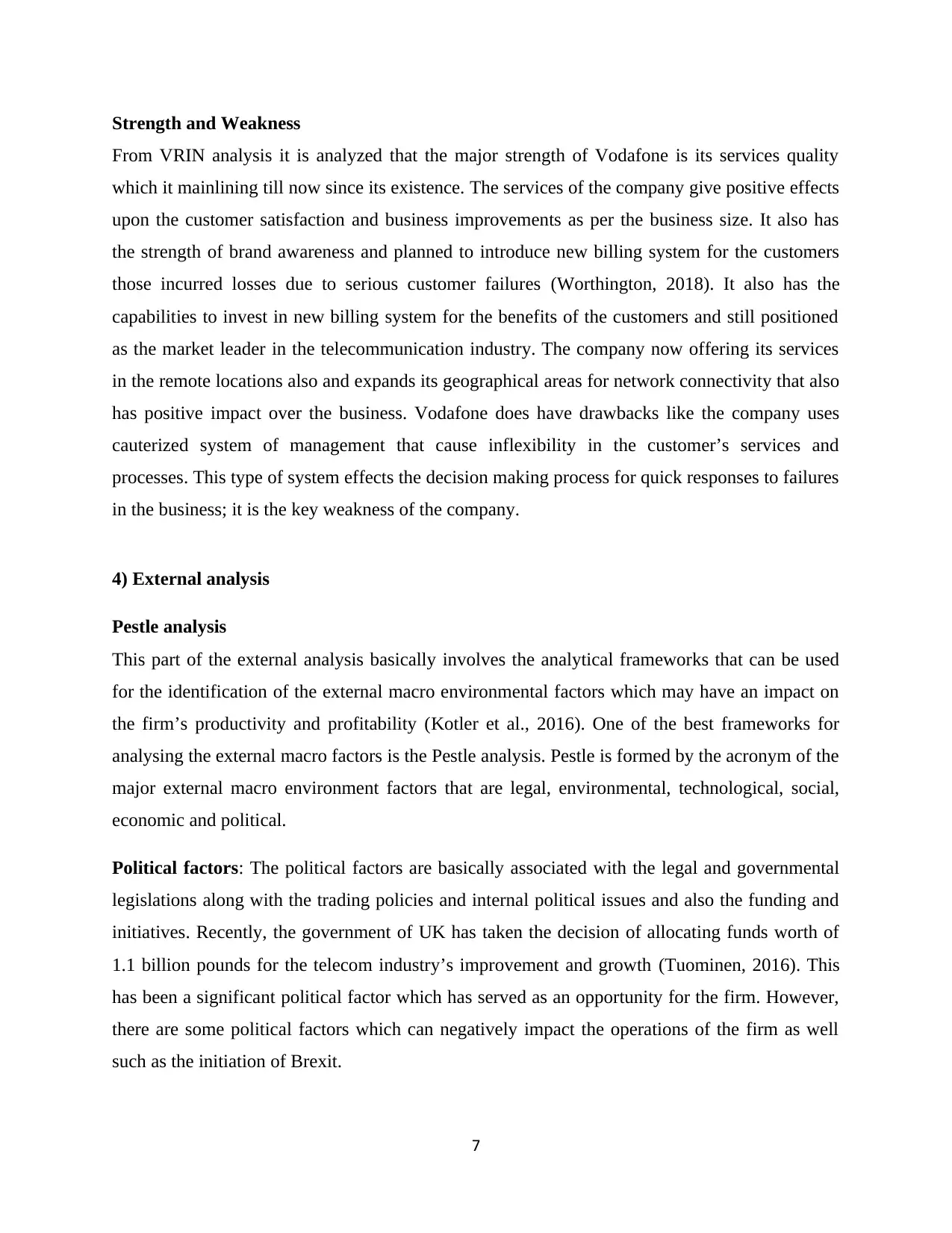
Strength and Weakness
From VRIN analysis it is analyzed that the major strength of Vodafone is its services quality
which it mainlining till now since its existence. The services of the company give positive effects
upon the customer satisfaction and business improvements as per the business size. It also has
the strength of brand awareness and planned to introduce new billing system for the customers
those incurred losses due to serious customer failures (Worthington, 2018). It also has the
capabilities to invest in new billing system for the benefits of the customers and still positioned
as the market leader in the telecommunication industry. The company now offering its services
in the remote locations also and expands its geographical areas for network connectivity that also
has positive impact over the business. Vodafone does have drawbacks like the company uses
cauterized system of management that cause inflexibility in the customer’s services and
processes. This type of system effects the decision making process for quick responses to failures
in the business; it is the key weakness of the company.
4) External analysis
Pestle analysis
This part of the external analysis basically involves the analytical frameworks that can be used
for the identification of the external macro environmental factors which may have an impact on
the firm’s productivity and profitability (Kotler et al., 2016). One of the best frameworks for
analysing the external macro factors is the Pestle analysis. Pestle is formed by the acronym of the
major external macro environment factors that are legal, environmental, technological, social,
economic and political.
Political factors: The political factors are basically associated with the legal and governmental
legislations along with the trading policies and internal political issues and also the funding and
initiatives. Recently, the government of UK has taken the decision of allocating funds worth of
1.1 billion pounds for the telecom industry’s improvement and growth (Tuominen, 2016). This
has been a significant political factor which has served as an opportunity for the firm. However,
there are some political factors which can negatively impact the operations of the firm as well
such as the initiation of Brexit.
7
From VRIN analysis it is analyzed that the major strength of Vodafone is its services quality
which it mainlining till now since its existence. The services of the company give positive effects
upon the customer satisfaction and business improvements as per the business size. It also has
the strength of brand awareness and planned to introduce new billing system for the customers
those incurred losses due to serious customer failures (Worthington, 2018). It also has the
capabilities to invest in new billing system for the benefits of the customers and still positioned
as the market leader in the telecommunication industry. The company now offering its services
in the remote locations also and expands its geographical areas for network connectivity that also
has positive impact over the business. Vodafone does have drawbacks like the company uses
cauterized system of management that cause inflexibility in the customer’s services and
processes. This type of system effects the decision making process for quick responses to failures
in the business; it is the key weakness of the company.
4) External analysis
Pestle analysis
This part of the external analysis basically involves the analytical frameworks that can be used
for the identification of the external macro environmental factors which may have an impact on
the firm’s productivity and profitability (Kotler et al., 2016). One of the best frameworks for
analysing the external macro factors is the Pestle analysis. Pestle is formed by the acronym of the
major external macro environment factors that are legal, environmental, technological, social,
economic and political.
Political factors: The political factors are basically associated with the legal and governmental
legislations along with the trading policies and internal political issues and also the funding and
initiatives. Recently, the government of UK has taken the decision of allocating funds worth of
1.1 billion pounds for the telecom industry’s improvement and growth (Tuominen, 2016). This
has been a significant political factor which has served as an opportunity for the firm. However,
there are some political factors which can negatively impact the operations of the firm as well
such as the initiation of Brexit.
7
Paraphrase This Document
Need a fresh take? Get an instant paraphrase of this document with our AI Paraphraser

Economic factors: The economic factors basically involve the aspect associated to the economy
of the country such as national and local economic growth, taxation system of the country and
the industrial growth rate (Alapo, 2018). Other than this, the telecom industry has also been
critically impacted by other economic factors like scopes of investment, contribution and market
share expansion. Other than this, the rates of the raw materials which are bought from other
nations are affected by the alterations in the rates of currency exchange, which ultimately
impacts the organization’s development cost.
Social factors: In terms of education, 90% of the country population has acquired primary
education which has made them capable of recognising the best offerings which are provided in
the lowest available prices (Tuominen, 2016). This factors is their required by effectively
considered by the firm as it follows the strategy of gaining strategic advantages over the
competitors by taking care of the society’s requirements for quality and standard offerings.
Technological factors: The organization requires much greater advancements in terms of
technology in order to develop services and products which are more innovative and effective
(Love, Roper & Bryson, 2011). Other than this, there have been various advancements in
technology which have provided the firm the opportunity of improving their present network,
such as GPS systems, internet calling and Wi-Fi services (Johri, 2010). However, due to the
increment in the company costs for implementing these advancements greatly impact the service
charge which the firm receives for the customers.
Legal factors: The laws and legislations of the nations which have an impact on the operations
of the company are basically involved in the legal factors like the laws of employment, health
and safety and contract laws as well (Tuominen, 2016). The telecom industry has been greatly
supported by the allowance of telecom equipments import and export by UK government.
Environmental factors: These are basically the factors by which the firm’s operations are
impacted on an ecological level (Wood et al., 2012). One of the most significant environmental
factors is globalization. This is mainly because the ethnicity of the customers for the issues
regarding environment has been increased due to globalization (Johri, 2010). Due to this, the
customer has grown a social expectation from their preferred organizations for the betterment of
the environment.
8
of the country such as national and local economic growth, taxation system of the country and
the industrial growth rate (Alapo, 2018). Other than this, the telecom industry has also been
critically impacted by other economic factors like scopes of investment, contribution and market
share expansion. Other than this, the rates of the raw materials which are bought from other
nations are affected by the alterations in the rates of currency exchange, which ultimately
impacts the organization’s development cost.
Social factors: In terms of education, 90% of the country population has acquired primary
education which has made them capable of recognising the best offerings which are provided in
the lowest available prices (Tuominen, 2016). This factors is their required by effectively
considered by the firm as it follows the strategy of gaining strategic advantages over the
competitors by taking care of the society’s requirements for quality and standard offerings.
Technological factors: The organization requires much greater advancements in terms of
technology in order to develop services and products which are more innovative and effective
(Love, Roper & Bryson, 2011). Other than this, there have been various advancements in
technology which have provided the firm the opportunity of improving their present network,
such as GPS systems, internet calling and Wi-Fi services (Johri, 2010). However, due to the
increment in the company costs for implementing these advancements greatly impact the service
charge which the firm receives for the customers.
Legal factors: The laws and legislations of the nations which have an impact on the operations
of the company are basically involved in the legal factors like the laws of employment, health
and safety and contract laws as well (Tuominen, 2016). The telecom industry has been greatly
supported by the allowance of telecom equipments import and export by UK government.
Environmental factors: These are basically the factors by which the firm’s operations are
impacted on an ecological level (Wood et al., 2012). One of the most significant environmental
factors is globalization. This is mainly because the ethnicity of the customers for the issues
regarding environment has been increased due to globalization (Johri, 2010). Due to this, the
customer has grown a social expectation from their preferred organizations for the betterment of
the environment.
8
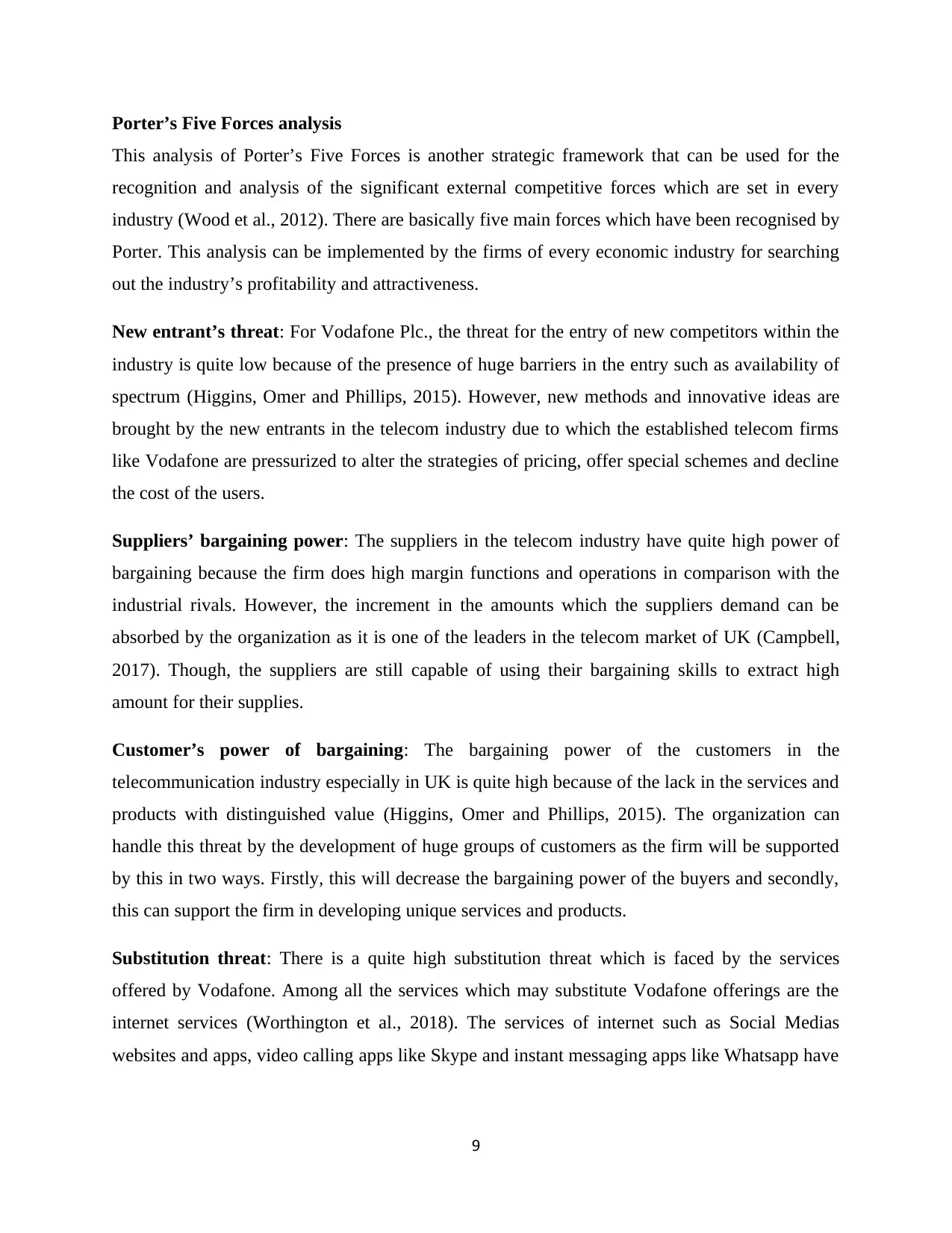
Porter’s Five Forces analysis
This analysis of Porter’s Five Forces is another strategic framework that can be used for the
recognition and analysis of the significant external competitive forces which are set in every
industry (Wood et al., 2012). There are basically five main forces which have been recognised by
Porter. This analysis can be implemented by the firms of every economic industry for searching
out the industry’s profitability and attractiveness.
New entrant’s threat: For Vodafone Plc., the threat for the entry of new competitors within the
industry is quite low because of the presence of huge barriers in the entry such as availability of
spectrum (Higgins, Omer and Phillips, 2015). However, new methods and innovative ideas are
brought by the new entrants in the telecom industry due to which the established telecom firms
like Vodafone are pressurized to alter the strategies of pricing, offer special schemes and decline
the cost of the users.
Suppliers’ bargaining power: The suppliers in the telecom industry have quite high power of
bargaining because the firm does high margin functions and operations in comparison with the
industrial rivals. However, the increment in the amounts which the suppliers demand can be
absorbed by the organization as it is one of the leaders in the telecom market of UK (Campbell,
2017). Though, the suppliers are still capable of using their bargaining skills to extract high
amount for their supplies.
Customer’s power of bargaining: The bargaining power of the customers in the
telecommunication industry especially in UK is quite high because of the lack in the services and
products with distinguished value (Higgins, Omer and Phillips, 2015). The organization can
handle this threat by the development of huge groups of customers as the firm will be supported
by this in two ways. Firstly, this will decrease the bargaining power of the buyers and secondly,
this can support the firm in developing unique services and products.
Substitution threat: There is a quite high substitution threat which is faced by the services
offered by Vodafone. Among all the services which may substitute Vodafone offerings are the
internet services (Worthington et al., 2018). The services of internet such as Social Medias
websites and apps, video calling apps like Skype and instant messaging apps like Whatsapp have
9
This analysis of Porter’s Five Forces is another strategic framework that can be used for the
recognition and analysis of the significant external competitive forces which are set in every
industry (Wood et al., 2012). There are basically five main forces which have been recognised by
Porter. This analysis can be implemented by the firms of every economic industry for searching
out the industry’s profitability and attractiveness.
New entrant’s threat: For Vodafone Plc., the threat for the entry of new competitors within the
industry is quite low because of the presence of huge barriers in the entry such as availability of
spectrum (Higgins, Omer and Phillips, 2015). However, new methods and innovative ideas are
brought by the new entrants in the telecom industry due to which the established telecom firms
like Vodafone are pressurized to alter the strategies of pricing, offer special schemes and decline
the cost of the users.
Suppliers’ bargaining power: The suppliers in the telecom industry have quite high power of
bargaining because the firm does high margin functions and operations in comparison with the
industrial rivals. However, the increment in the amounts which the suppliers demand can be
absorbed by the organization as it is one of the leaders in the telecom market of UK (Campbell,
2017). Though, the suppliers are still capable of using their bargaining skills to extract high
amount for their supplies.
Customer’s power of bargaining: The bargaining power of the customers in the
telecommunication industry especially in UK is quite high because of the lack in the services and
products with distinguished value (Higgins, Omer and Phillips, 2015). The organization can
handle this threat by the development of huge groups of customers as the firm will be supported
by this in two ways. Firstly, this will decrease the bargaining power of the buyers and secondly,
this can support the firm in developing unique services and products.
Substitution threat: There is a quite high substitution threat which is faced by the services
offered by Vodafone. Among all the services which may substitute Vodafone offerings are the
internet services (Worthington et al., 2018). The services of internet such as Social Medias
websites and apps, video calling apps like Skype and instant messaging apps like Whatsapp have
9
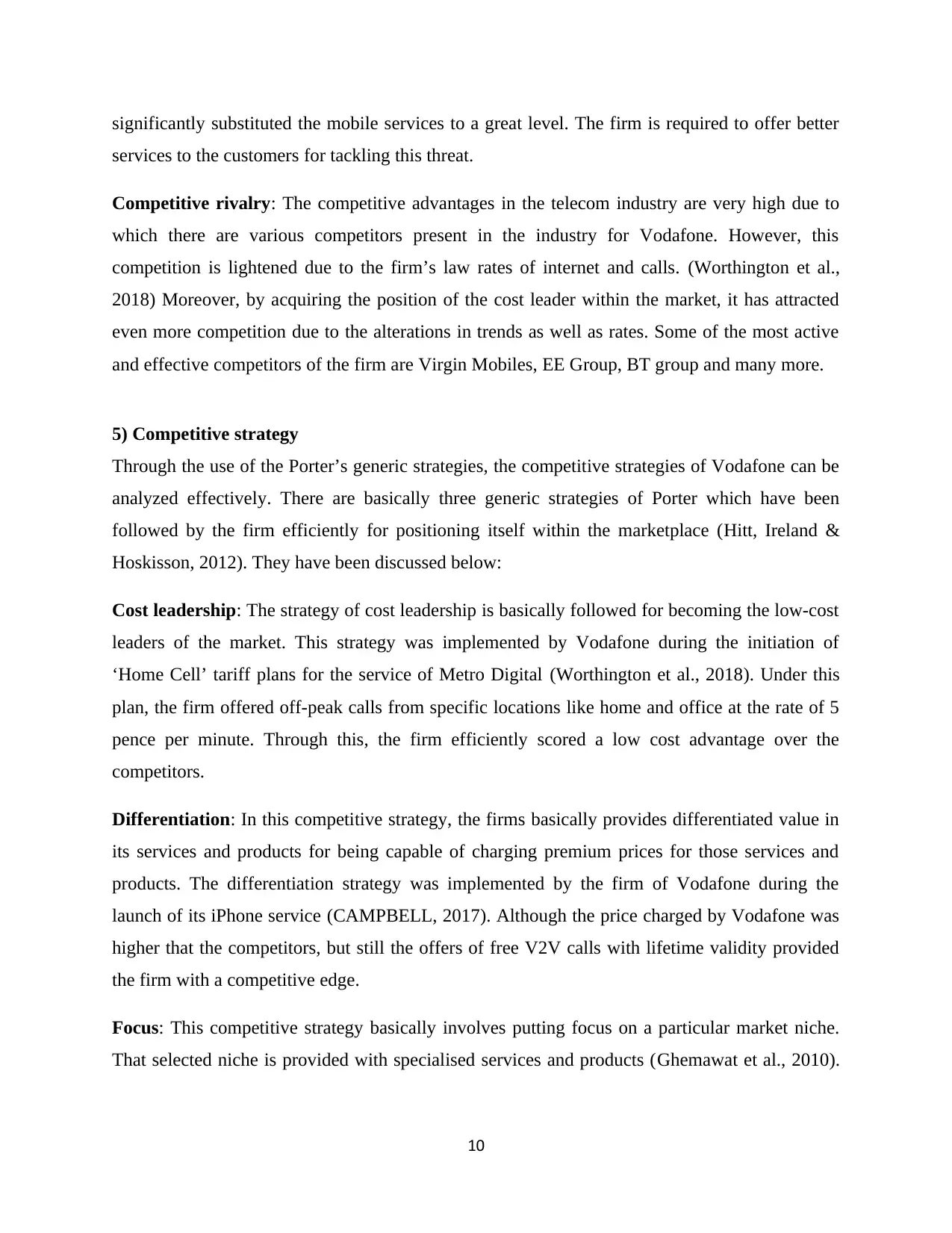
significantly substituted the mobile services to a great level. The firm is required to offer better
services to the customers for tackling this threat.
Competitive rivalry: The competitive advantages in the telecom industry are very high due to
which there are various competitors present in the industry for Vodafone. However, this
competition is lightened due to the firm’s law rates of internet and calls. (Worthington et al.,
2018) Moreover, by acquiring the position of the cost leader within the market, it has attracted
even more competition due to the alterations in trends as well as rates. Some of the most active
and effective competitors of the firm are Virgin Mobiles, EE Group, BT group and many more.
5) Competitive strategy
Through the use of the Porter’s generic strategies, the competitive strategies of Vodafone can be
analyzed effectively. There are basically three generic strategies of Porter which have been
followed by the firm efficiently for positioning itself within the marketplace (Hitt, Ireland &
Hoskisson, 2012). They have been discussed below:
Cost leadership: The strategy of cost leadership is basically followed for becoming the low-cost
leaders of the market. This strategy was implemented by Vodafone during the initiation of
‘Home Cell’ tariff plans for the service of Metro Digital (Worthington et al., 2018). Under this
plan, the firm offered off-peak calls from specific locations like home and office at the rate of 5
pence per minute. Through this, the firm efficiently scored a low cost advantage over the
competitors.
Differentiation: In this competitive strategy, the firms basically provides differentiated value in
its services and products for being capable of charging premium prices for those services and
products. The differentiation strategy was implemented by the firm of Vodafone during the
launch of its iPhone service (CAMPBELL, 2017). Although the price charged by Vodafone was
higher that the competitors, but still the offers of free V2V calls with lifetime validity provided
the firm with a competitive edge.
Focus: This competitive strategy basically involves putting focus on a particular market niche.
That selected niche is provided with specialised services and products (Ghemawat et al., 2010).
10
services to the customers for tackling this threat.
Competitive rivalry: The competitive advantages in the telecom industry are very high due to
which there are various competitors present in the industry for Vodafone. However, this
competition is lightened due to the firm’s law rates of internet and calls. (Worthington et al.,
2018) Moreover, by acquiring the position of the cost leader within the market, it has attracted
even more competition due to the alterations in trends as well as rates. Some of the most active
and effective competitors of the firm are Virgin Mobiles, EE Group, BT group and many more.
5) Competitive strategy
Through the use of the Porter’s generic strategies, the competitive strategies of Vodafone can be
analyzed effectively. There are basically three generic strategies of Porter which have been
followed by the firm efficiently for positioning itself within the marketplace (Hitt, Ireland &
Hoskisson, 2012). They have been discussed below:
Cost leadership: The strategy of cost leadership is basically followed for becoming the low-cost
leaders of the market. This strategy was implemented by Vodafone during the initiation of
‘Home Cell’ tariff plans for the service of Metro Digital (Worthington et al., 2018). Under this
plan, the firm offered off-peak calls from specific locations like home and office at the rate of 5
pence per minute. Through this, the firm efficiently scored a low cost advantage over the
competitors.
Differentiation: In this competitive strategy, the firms basically provides differentiated value in
its services and products for being capable of charging premium prices for those services and
products. The differentiation strategy was implemented by the firm of Vodafone during the
launch of its iPhone service (CAMPBELL, 2017). Although the price charged by Vodafone was
higher that the competitors, but still the offers of free V2V calls with lifetime validity provided
the firm with a competitive edge.
Focus: This competitive strategy basically involves putting focus on a particular market niche.
That selected niche is provided with specialised services and products (Ghemawat et al., 2010).
10
Secure Best Marks with AI Grader
Need help grading? Try our AI Grader for instant feedback on your assignments.

This strategy was utilized by the firm during the introduction of One Net for offering mobile
voice services specifically to the SMEs.
6) Ansoff Growth Matrix
The strategic planning tool of Ansoff growth Matrix was first developed by H. Igor Ansoff in
1957 (Teece, 2010). It basically provides a framework for the assistance of the executives of the
concerned organization as well as its marketers and managers in the organization’s future growth
and expansion. The organization’s senior executives are supported by this framework in the
achievement of the organization’s desires and motives. There are four factors in this growth
matrix:
Market penetration: In this factor of the growth matrix, the firm emphasizes on the selling of
the existing services of the firm in the markets in which the firm already operates with the
motive of management, maintenance and enhancement of the existing services’ share in the
existing market (Tuominen, 2016). The advertisement and promotional strategies of the firm are
required to be more endorsed in order to implement this strategy efficiently.
Market development: In the aspect of market development, the emphasis of the firm is put on
selling the existing services of the firm in the markets where the firm didn’t operated before
(Worthington et al., 2018). The popularity and market share of Vodafone in the telecom industry
of United Kingdom is huge. However, the firm’s services have not yet reached the nation’s urban
regions where there is an opportunity of earning huge revenues. The firm can use the market
development strategy for spreading its operations in such regions.
Product development: In the aspect of product development, the organizations basically focus
on the promotion of new services and products in the market where the firm already operates and
is renowned among the customers (Freeman, 2010). This product development strategy is
generally preferable in those customer markets where the services with unique features and
differentiated value are preferred.
Diversification: For this aspect of the growth matrix, clear perceptions about the achievements
that can be acquired from the strategy should be acquired by the company (David, 2011). This is
the most complicated aspect in the growth matrix as it involves both markets as well as product
11
voice services specifically to the SMEs.
6) Ansoff Growth Matrix
The strategic planning tool of Ansoff growth Matrix was first developed by H. Igor Ansoff in
1957 (Teece, 2010). It basically provides a framework for the assistance of the executives of the
concerned organization as well as its marketers and managers in the organization’s future growth
and expansion. The organization’s senior executives are supported by this framework in the
achievement of the organization’s desires and motives. There are four factors in this growth
matrix:
Market penetration: In this factor of the growth matrix, the firm emphasizes on the selling of
the existing services of the firm in the markets in which the firm already operates with the
motive of management, maintenance and enhancement of the existing services’ share in the
existing market (Tuominen, 2016). The advertisement and promotional strategies of the firm are
required to be more endorsed in order to implement this strategy efficiently.
Market development: In the aspect of market development, the emphasis of the firm is put on
selling the existing services of the firm in the markets where the firm didn’t operated before
(Worthington et al., 2018). The popularity and market share of Vodafone in the telecom industry
of United Kingdom is huge. However, the firm’s services have not yet reached the nation’s urban
regions where there is an opportunity of earning huge revenues. The firm can use the market
development strategy for spreading its operations in such regions.
Product development: In the aspect of product development, the organizations basically focus
on the promotion of new services and products in the market where the firm already operates and
is renowned among the customers (Freeman, 2010). This product development strategy is
generally preferable in those customer markets where the services with unique features and
differentiated value are preferred.
Diversification: For this aspect of the growth matrix, clear perceptions about the achievements
that can be acquired from the strategy should be acquired by the company (David, 2011). This is
the most complicated aspect in the growth matrix as it involves both markets as well as product
11
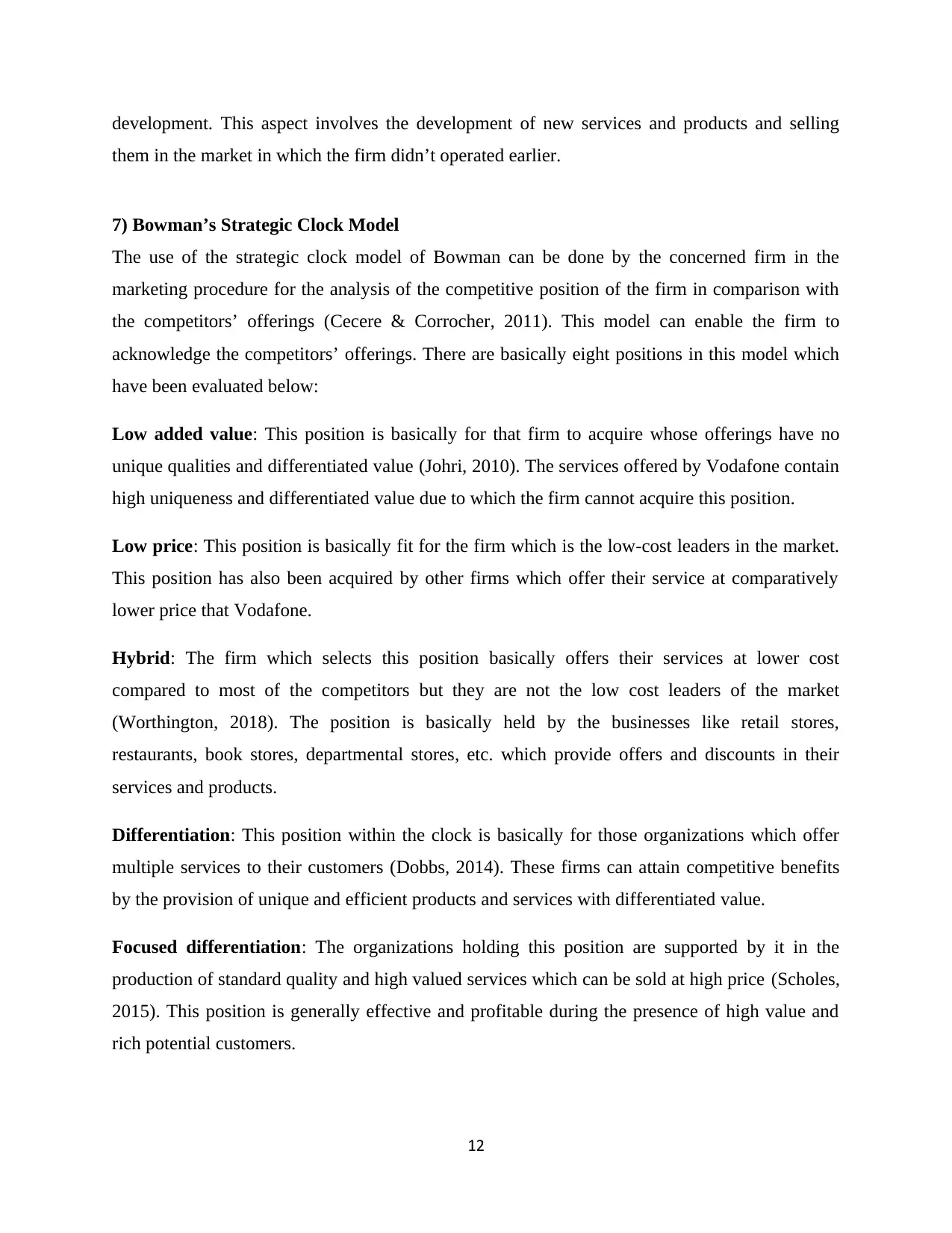
development. This aspect involves the development of new services and products and selling
them in the market in which the firm didn’t operated earlier.
7) Bowman’s Strategic Clock Model
The use of the strategic clock model of Bowman can be done by the concerned firm in the
marketing procedure for the analysis of the competitive position of the firm in comparison with
the competitors’ offerings (Cecere & Corrocher, 2011). This model can enable the firm to
acknowledge the competitors’ offerings. There are basically eight positions in this model which
have been evaluated below:
Low added value: This position is basically for that firm to acquire whose offerings have no
unique qualities and differentiated value (Johri, 2010). The services offered by Vodafone contain
high uniqueness and differentiated value due to which the firm cannot acquire this position.
Low price: This position is basically fit for the firm which is the low-cost leaders in the market.
This position has also been acquired by other firms which offer their service at comparatively
lower price that Vodafone.
Hybrid: The firm which selects this position basically offers their services at lower cost
compared to most of the competitors but they are not the low cost leaders of the market
(Worthington, 2018). The position is basically held by the businesses like retail stores,
restaurants, book stores, departmental stores, etc. which provide offers and discounts in their
services and products.
Differentiation: This position within the clock is basically for those organizations which offer
multiple services to their customers (Dobbs, 2014). These firms can attain competitive benefits
by the provision of unique and efficient products and services with differentiated value.
Focused differentiation: The organizations holding this position are supported by it in the
production of standard quality and high valued services which can be sold at high price (Scholes,
2015). This position is generally effective and profitable during the presence of high value and
rich potential customers.
12
them in the market in which the firm didn’t operated earlier.
7) Bowman’s Strategic Clock Model
The use of the strategic clock model of Bowman can be done by the concerned firm in the
marketing procedure for the analysis of the competitive position of the firm in comparison with
the competitors’ offerings (Cecere & Corrocher, 2011). This model can enable the firm to
acknowledge the competitors’ offerings. There are basically eight positions in this model which
have been evaluated below:
Low added value: This position is basically for that firm to acquire whose offerings have no
unique qualities and differentiated value (Johri, 2010). The services offered by Vodafone contain
high uniqueness and differentiated value due to which the firm cannot acquire this position.
Low price: This position is basically fit for the firm which is the low-cost leaders in the market.
This position has also been acquired by other firms which offer their service at comparatively
lower price that Vodafone.
Hybrid: The firm which selects this position basically offers their services at lower cost
compared to most of the competitors but they are not the low cost leaders of the market
(Worthington, 2018). The position is basically held by the businesses like retail stores,
restaurants, book stores, departmental stores, etc. which provide offers and discounts in their
services and products.
Differentiation: This position within the clock is basically for those organizations which offer
multiple services to their customers (Dobbs, 2014). These firms can attain competitive benefits
by the provision of unique and efficient products and services with differentiated value.
Focused differentiation: The organizations holding this position are supported by it in the
production of standard quality and high valued services which can be sold at high price (Scholes,
2015). This position is generally effective and profitable during the presence of high value and
rich potential customers.
12
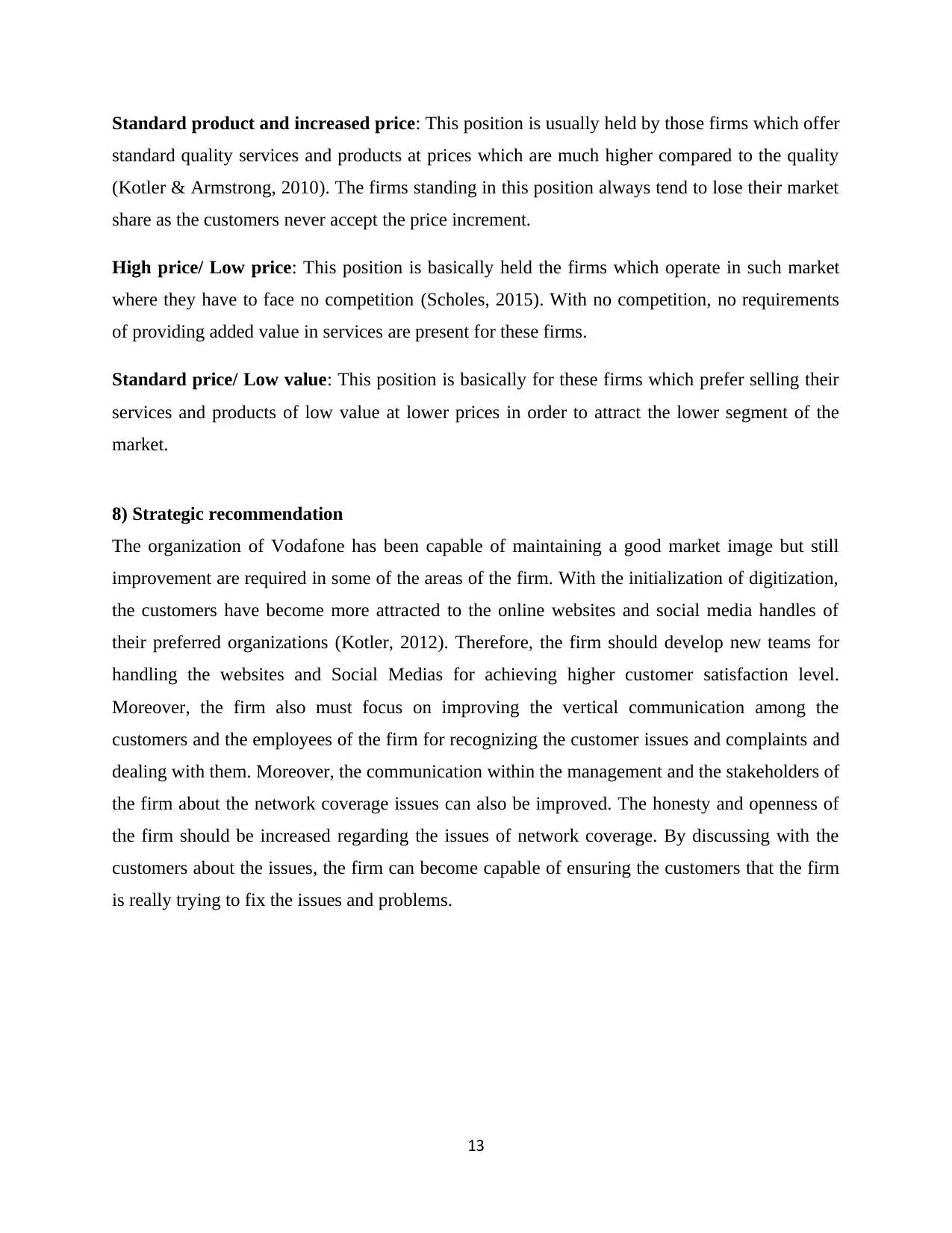
Standard product and increased price: This position is usually held by those firms which offer
standard quality services and products at prices which are much higher compared to the quality
(Kotler & Armstrong, 2010). The firms standing in this position always tend to lose their market
share as the customers never accept the price increment.
High price/ Low price: This position is basically held the firms which operate in such market
where they have to face no competition (Scholes, 2015). With no competition, no requirements
of providing added value in services are present for these firms.
Standard price/ Low value: This position is basically for these firms which prefer selling their
services and products of low value at lower prices in order to attract the lower segment of the
market.
8) Strategic recommendation
The organization of Vodafone has been capable of maintaining a good market image but still
improvement are required in some of the areas of the firm. With the initialization of digitization,
the customers have become more attracted to the online websites and social media handles of
their preferred organizations (Kotler, 2012). Therefore, the firm should develop new teams for
handling the websites and Social Medias for achieving higher customer satisfaction level.
Moreover, the firm also must focus on improving the vertical communication among the
customers and the employees of the firm for recognizing the customer issues and complaints and
dealing with them. Moreover, the communication within the management and the stakeholders of
the firm about the network coverage issues can also be improved. The honesty and openness of
the firm should be increased regarding the issues of network coverage. By discussing with the
customers about the issues, the firm can become capable of ensuring the customers that the firm
is really trying to fix the issues and problems.
13
standard quality services and products at prices which are much higher compared to the quality
(Kotler & Armstrong, 2010). The firms standing in this position always tend to lose their market
share as the customers never accept the price increment.
High price/ Low price: This position is basically held the firms which operate in such market
where they have to face no competition (Scholes, 2015). With no competition, no requirements
of providing added value in services are present for these firms.
Standard price/ Low value: This position is basically for these firms which prefer selling their
services and products of low value at lower prices in order to attract the lower segment of the
market.
8) Strategic recommendation
The organization of Vodafone has been capable of maintaining a good market image but still
improvement are required in some of the areas of the firm. With the initialization of digitization,
the customers have become more attracted to the online websites and social media handles of
their preferred organizations (Kotler, 2012). Therefore, the firm should develop new teams for
handling the websites and Social Medias for achieving higher customer satisfaction level.
Moreover, the firm also must focus on improving the vertical communication among the
customers and the employees of the firm for recognizing the customer issues and complaints and
dealing with them. Moreover, the communication within the management and the stakeholders of
the firm about the network coverage issues can also be improved. The honesty and openness of
the firm should be increased regarding the issues of network coverage. By discussing with the
customers about the issues, the firm can become capable of ensuring the customers that the firm
is really trying to fix the issues and problems.
13
Paraphrase This Document
Need a fresh take? Get an instant paraphrase of this document with our AI Paraphraser
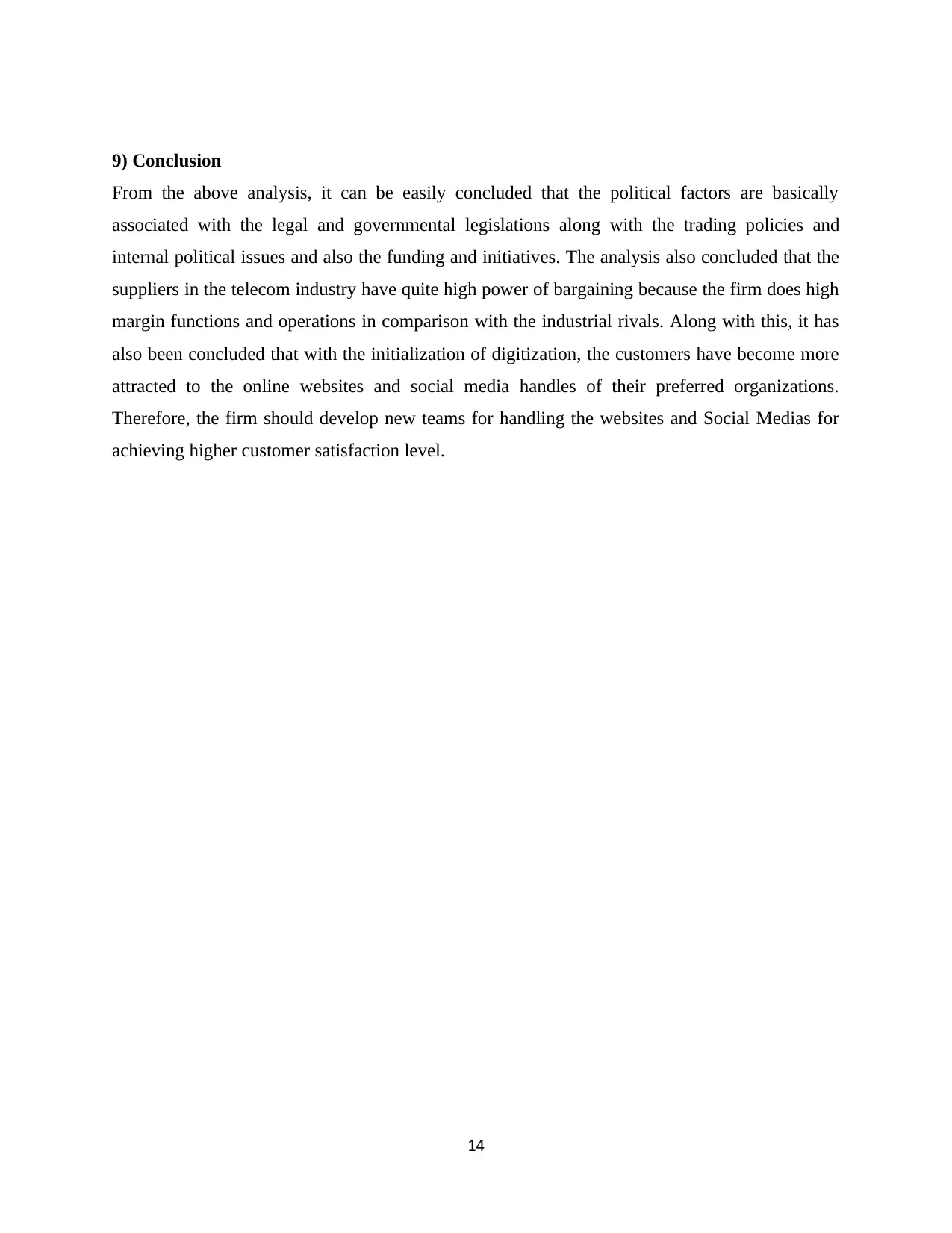
9) Conclusion
From the above analysis, it can be easily concluded that the political factors are basically
associated with the legal and governmental legislations along with the trading policies and
internal political issues and also the funding and initiatives. The analysis also concluded that the
suppliers in the telecom industry have quite high power of bargaining because the firm does high
margin functions and operations in comparison with the industrial rivals. Along with this, it has
also been concluded that with the initialization of digitization, the customers have become more
attracted to the online websites and social media handles of their preferred organizations.
Therefore, the firm should develop new teams for handling the websites and Social Medias for
achieving higher customer satisfaction level.
14
From the above analysis, it can be easily concluded that the political factors are basically
associated with the legal and governmental legislations along with the trading policies and
internal political issues and also the funding and initiatives. The analysis also concluded that the
suppliers in the telecom industry have quite high power of bargaining because the firm does high
margin functions and operations in comparison with the industrial rivals. Along with this, it has
also been concluded that with the initialization of digitization, the customers have become more
attracted to the online websites and social media handles of their preferred organizations.
Therefore, the firm should develop new teams for handling the websites and Social Medias for
achieving higher customer satisfaction level.
14
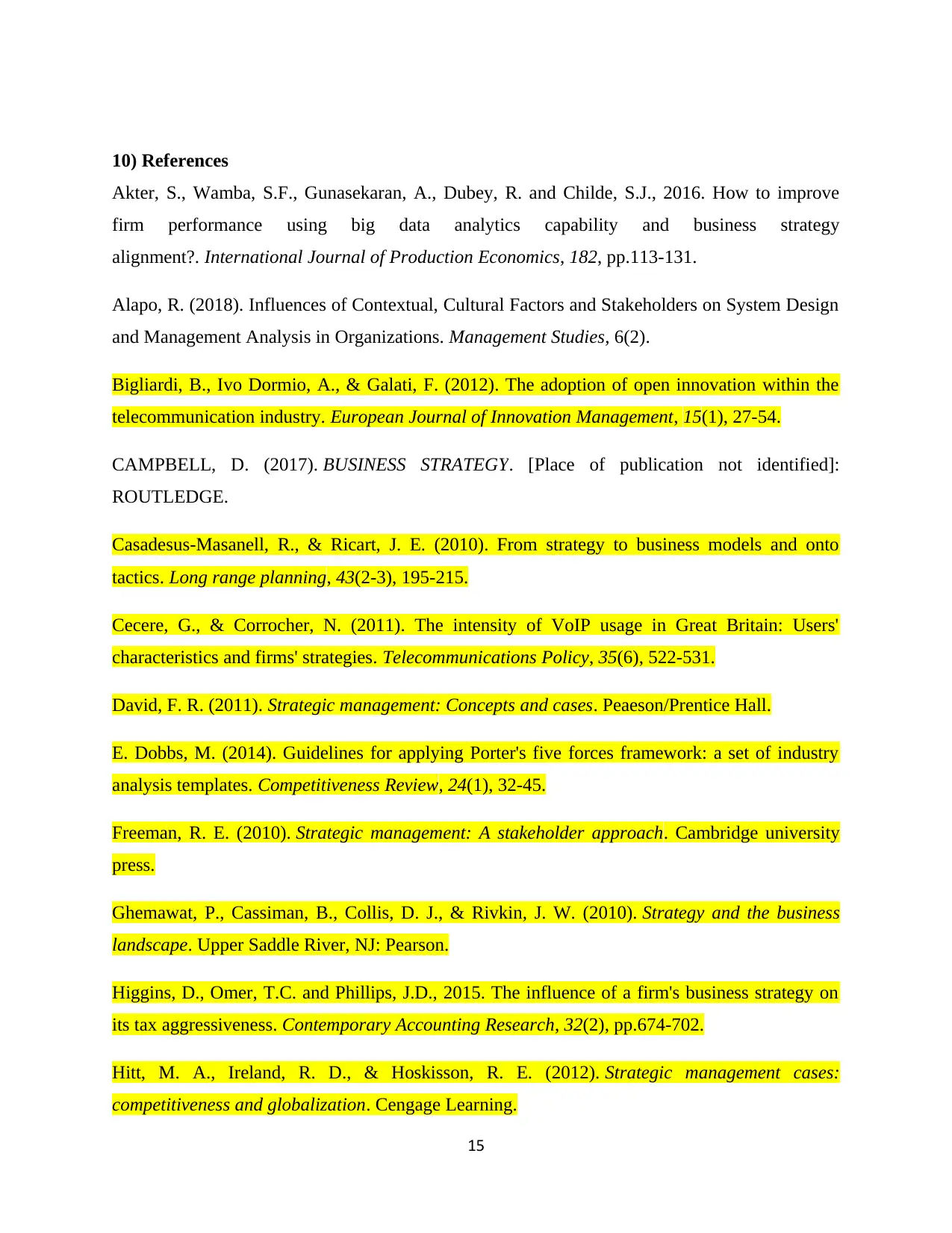
10) References
Akter, S., Wamba, S.F., Gunasekaran, A., Dubey, R. and Childe, S.J., 2016. How to improve
firm performance using big data analytics capability and business strategy
alignment?. International Journal of Production Economics, 182, pp.113-131.
Alapo, R. (2018). Influences of Contextual, Cultural Factors and Stakeholders on System Design
and Management Analysis in Organizations. Management Studies, 6(2).
Bigliardi, B., Ivo Dormio, A., & Galati, F. (2012). The adoption of open innovation within the
telecommunication industry. European Journal of Innovation Management, 15(1), 27-54.
CAMPBELL, D. (2017). BUSINESS STRATEGY. [Place of publication not identified]:
ROUTLEDGE.
Casadesus-Masanell, R., & Ricart, J. E. (2010). From strategy to business models and onto
tactics. Long range planning, 43(2-3), 195-215.
Cecere, G., & Corrocher, N. (2011). The intensity of VoIP usage in Great Britain: Users'
characteristics and firms' strategies. Telecommunications Policy, 35(6), 522-531.
David, F. R. (2011). Strategic management: Concepts and cases. Peaeson/Prentice Hall.
E. Dobbs, M. (2014). Guidelines for applying Porter's five forces framework: a set of industry
analysis templates. Competitiveness Review, 24(1), 32-45.
Freeman, R. E. (2010). Strategic management: A stakeholder approach. Cambridge university
press.
Ghemawat, P., Cassiman, B., Collis, D. J., & Rivkin, J. W. (2010). Strategy and the business
landscape. Upper Saddle River, NJ: Pearson.
Higgins, D., Omer, T.C. and Phillips, J.D., 2015. The influence of a firm's business strategy on
its tax aggressiveness. Contemporary Accounting Research, 32(2), pp.674-702.
Hitt, M. A., Ireland, R. D., & Hoskisson, R. E. (2012). Strategic management cases:
competitiveness and globalization. Cengage Learning.
15
Akter, S., Wamba, S.F., Gunasekaran, A., Dubey, R. and Childe, S.J., 2016. How to improve
firm performance using big data analytics capability and business strategy
alignment?. International Journal of Production Economics, 182, pp.113-131.
Alapo, R. (2018). Influences of Contextual, Cultural Factors and Stakeholders on System Design
and Management Analysis in Organizations. Management Studies, 6(2).
Bigliardi, B., Ivo Dormio, A., & Galati, F. (2012). The adoption of open innovation within the
telecommunication industry. European Journal of Innovation Management, 15(1), 27-54.
CAMPBELL, D. (2017). BUSINESS STRATEGY. [Place of publication not identified]:
ROUTLEDGE.
Casadesus-Masanell, R., & Ricart, J. E. (2010). From strategy to business models and onto
tactics. Long range planning, 43(2-3), 195-215.
Cecere, G., & Corrocher, N. (2011). The intensity of VoIP usage in Great Britain: Users'
characteristics and firms' strategies. Telecommunications Policy, 35(6), 522-531.
David, F. R. (2011). Strategic management: Concepts and cases. Peaeson/Prentice Hall.
E. Dobbs, M. (2014). Guidelines for applying Porter's five forces framework: a set of industry
analysis templates. Competitiveness Review, 24(1), 32-45.
Freeman, R. E. (2010). Strategic management: A stakeholder approach. Cambridge university
press.
Ghemawat, P., Cassiman, B., Collis, D. J., & Rivkin, J. W. (2010). Strategy and the business
landscape. Upper Saddle River, NJ: Pearson.
Higgins, D., Omer, T.C. and Phillips, J.D., 2015. The influence of a firm's business strategy on
its tax aggressiveness. Contemporary Accounting Research, 32(2), pp.674-702.
Hitt, M. A., Ireland, R. D., & Hoskisson, R. E. (2012). Strategic management cases:
competitiveness and globalization. Cengage Learning.
15
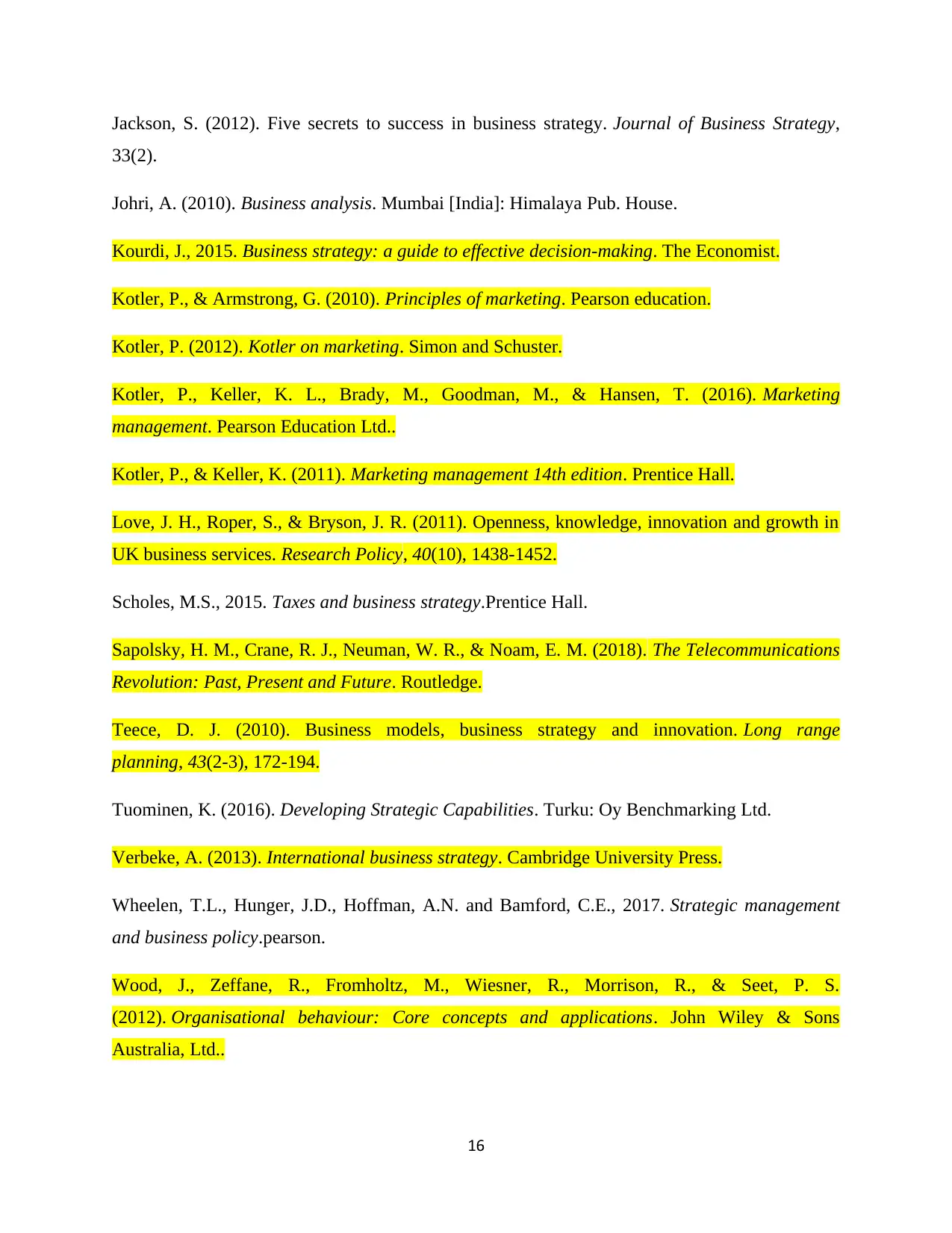
Jackson, S. (2012). Five secrets to success in business strategy. Journal of Business Strategy,
33(2).
Johri, A. (2010). Business analysis. Mumbai [India]: Himalaya Pub. House.
Kourdi, J., 2015. Business strategy: a guide to effective decision-making. The Economist.
Kotler, P., & Armstrong, G. (2010). Principles of marketing. Pearson education.
Kotler, P. (2012). Kotler on marketing. Simon and Schuster.
Kotler, P., Keller, K. L., Brady, M., Goodman, M., & Hansen, T. (2016). Marketing
management. Pearson Education Ltd..
Kotler, P., & Keller, K. (2011). Marketing management 14th edition. Prentice Hall.
Love, J. H., Roper, S., & Bryson, J. R. (2011). Openness, knowledge, innovation and growth in
UK business services. Research Policy, 40(10), 1438-1452.
Scholes, M.S., 2015. Taxes and business strategy.Prentice Hall.
Sapolsky, H. M., Crane, R. J., Neuman, W. R., & Noam, E. M. (2018). The Telecommunications
Revolution: Past, Present and Future. Routledge.
Teece, D. J. (2010). Business models, business strategy and innovation. Long range
planning, 43(2-3), 172-194.
Tuominen, K. (2016). Developing Strategic Capabilities. Turku: Oy Benchmarking Ltd.
Verbeke, A. (2013). International business strategy. Cambridge University Press.
Wheelen, T.L., Hunger, J.D., Hoffman, A.N. and Bamford, C.E., 2017. Strategic management
and business policy.pearson.
Wood, J., Zeffane, R., Fromholtz, M., Wiesner, R., Morrison, R., & Seet, P. S.
(2012). Organisational behaviour: Core concepts and applications. John Wiley & Sons
Australia, Ltd..
16
33(2).
Johri, A. (2010). Business analysis. Mumbai [India]: Himalaya Pub. House.
Kourdi, J., 2015. Business strategy: a guide to effective decision-making. The Economist.
Kotler, P., & Armstrong, G. (2010). Principles of marketing. Pearson education.
Kotler, P. (2012). Kotler on marketing. Simon and Schuster.
Kotler, P., Keller, K. L., Brady, M., Goodman, M., & Hansen, T. (2016). Marketing
management. Pearson Education Ltd..
Kotler, P., & Keller, K. (2011). Marketing management 14th edition. Prentice Hall.
Love, J. H., Roper, S., & Bryson, J. R. (2011). Openness, knowledge, innovation and growth in
UK business services. Research Policy, 40(10), 1438-1452.
Scholes, M.S., 2015. Taxes and business strategy.Prentice Hall.
Sapolsky, H. M., Crane, R. J., Neuman, W. R., & Noam, E. M. (2018). The Telecommunications
Revolution: Past, Present and Future. Routledge.
Teece, D. J. (2010). Business models, business strategy and innovation. Long range
planning, 43(2-3), 172-194.
Tuominen, K. (2016). Developing Strategic Capabilities. Turku: Oy Benchmarking Ltd.
Verbeke, A. (2013). International business strategy. Cambridge University Press.
Wheelen, T.L., Hunger, J.D., Hoffman, A.N. and Bamford, C.E., 2017. Strategic management
and business policy.pearson.
Wood, J., Zeffane, R., Fromholtz, M., Wiesner, R., Morrison, R., & Seet, P. S.
(2012). Organisational behaviour: Core concepts and applications. John Wiley & Sons
Australia, Ltd..
16
Secure Best Marks with AI Grader
Need help grading? Try our AI Grader for instant feedback on your assignments.

Worthington, I., Britton, C. and Thompson, E. (2018). The Business Environment. Harlow,
United Kingdom: Pearson Education Limited.
17
United Kingdom: Pearson Education Limited.
17
1 out of 17
Related Documents
Your All-in-One AI-Powered Toolkit for Academic Success.
+13062052269
info@desklib.com
Available 24*7 on WhatsApp / Email
![[object Object]](/_next/static/media/star-bottom.7253800d.svg)
Unlock your academic potential
© 2024 | Zucol Services PVT LTD | All rights reserved.





